I’m not a skier, so on a recent trip to the Jungfrau region in Switzerland, I went in search of alternative Winter activities. What I discovered was that I could experience the majesty, excitement and general brilliance of the Swiss Alps just as skiers do, but without any specialist knowledge and without spending a fortune on expensive equipment. All I needed was a sturdy pair of waterproof boots and a general idea of where I wanted to end up.
Warning: Winter hiking in the Jungfrau region can be dangerous! Always seek professional and local advice if you’re unsure. If something looks dangerous, it probably is, so trust your instincts.
Winter Hiking in the Jungfrau Region
In this post, we’ll be looking at my experience of Winter hiking in the Jungfrau region. Winter hiking combines two of my favourite things; exploration and snow. There’s nothing quite like hearing the scrunch of freshly fallen snow under-foot whilst being surrounded by some of the world’s most dramatic mountain scenery. We’ll be looking at two hiking routes in the region, one pretty easy, the other rather more challenging. We’ll then explore some of the things I learnt on my hikes, so that you can enjoy them as safely as I did.
Let’s begin our look at Winter hiking in the Jungfrau region by looking at the easier hike of the two, a route from Grütschalp to Mürren.
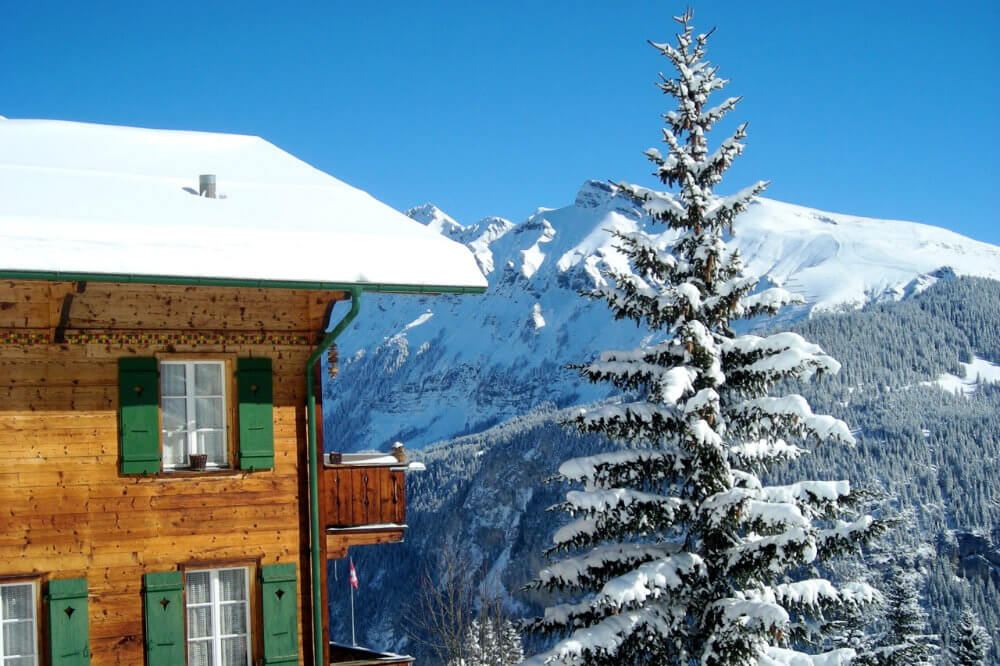
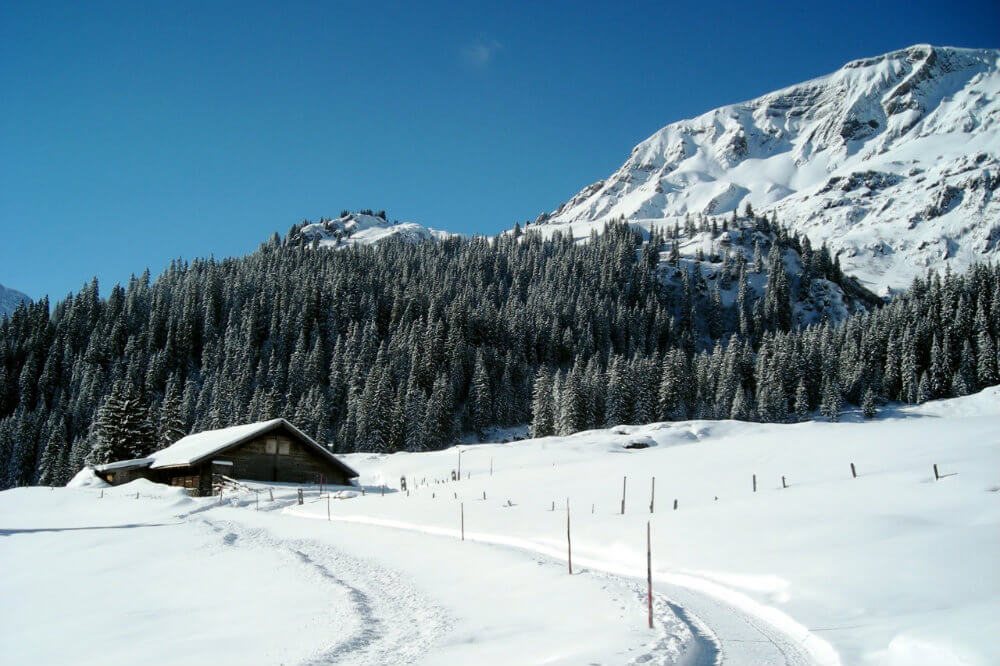
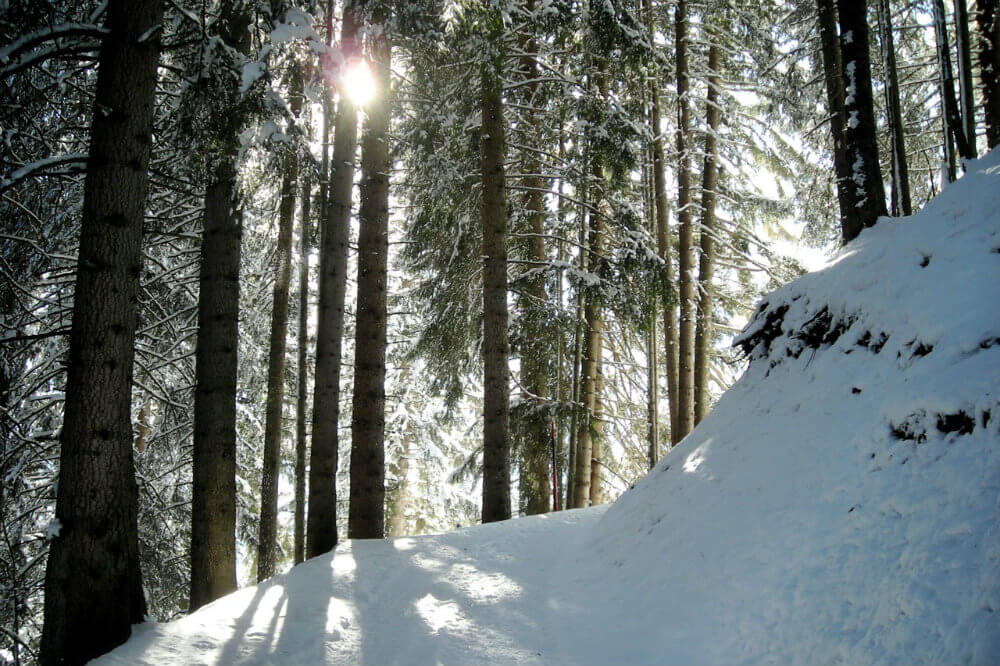
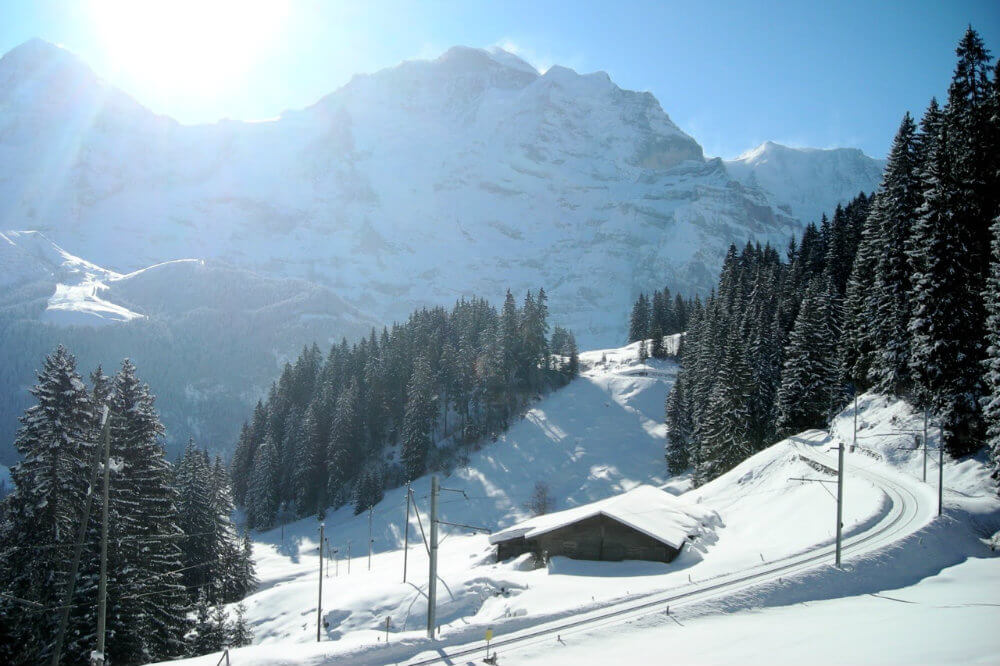
Winter Hiking from Grütschalp to Mürren
This route was a mostly flat 4.4km walk from Grütschalp station (1486m) to Mürren (1650m) via Winteregg station (1578m). As well as being really easy, this walk rewards your effort with truly spectacular views from beginning to end.
To get to Grütschalp, you’ll need to take the gondola from Lauterbrunnen. The gondola station is just across the road from the train station, so it’s very easy to find. Once you’ve reached Grütschalp, exit the station and you’ll see a sign pointing south to Mürren.
Practically impossible to get lost
The train line to Mürren runs adjacent to the entire hiking route, so it’s practically impossible to get lost along the way. For this reason, this path is a great way to introduce yourself to hiking in snow. The route hardly ever closes and is routinely cleared most mornings, even after a heavy fall of snow. Most mapped walking paths in the region are carefully managed and authorities will close paths if they deem them unsafe. With a good pair of boots and with consideration for time spent staring open-mouthed at the stunning scenery, you should be in the beautiful, tranquil, car-free village of Mürren well within two hours.
Instagram-friendly
Along the way, you’ll pass through pine woodland, large snow fields, tiny settlements and Winteregg, an intermediate train station where you’ll find a ski lift and restaurant (Winter season only). As you progress, keep your eyes peeled for Instagram-friendly log stacks, remote huts that surely no one can live in and hauntingly beautiful frozen waterfalls.
The hike from Grütschalp to Mürren is great for all ages. If though you’re looking for something more challenging, keep reading. The hike from Männlichen to Kleine Scheidegg on the other side of the valley will probably meet your requirements.
[htt-tripadvisor-box location=”Lauterbrunnen” url=”https://heretotravel.com/go/tripadvisor-lauterbrunnen/”]
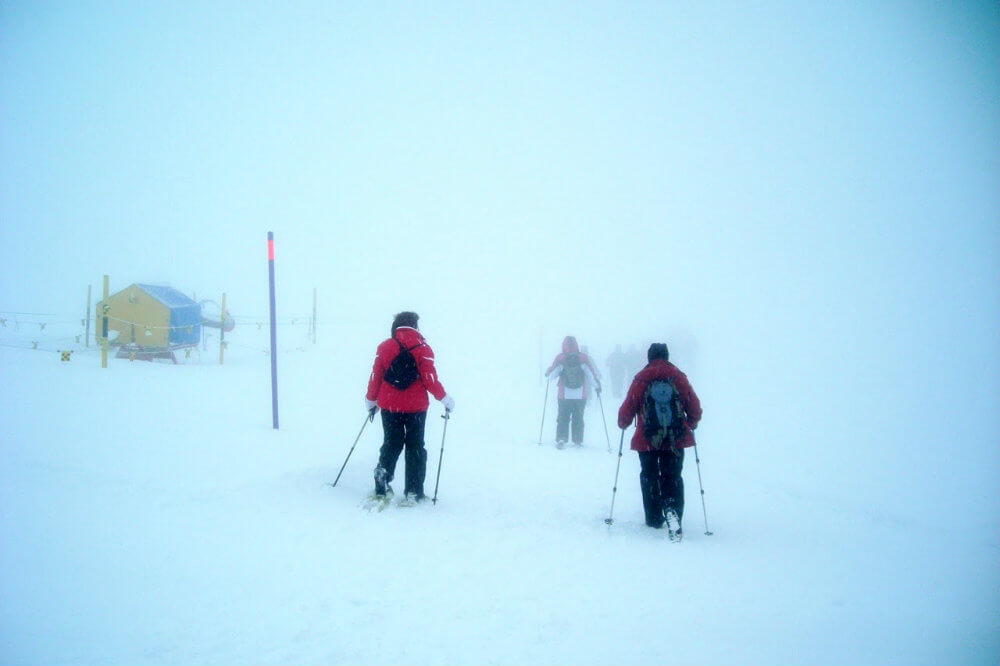




Winter Hiking from Männlichen to Kleine Scheidegg
The hike between Männlichen and Kleine Scheidegg is advertised on various websites with a variety of completion times, distances and difficulty ratings. This seems to suggest the route changes with the seasons. The route I tackled in the Winter season was just over 6km in length, took 2hrs 40mns to complete and offered a series of challenges. If experiencing true mountain wilderness and challenging yourself to reach difficult goals is your thing, you should try this hike.
Keep your eyes peeled
The route meanders across several ski runs (so be careful when crossing them) and climbs and descends throughout. You start the walk at 2230m and actually end up at a slightly lower altitude of 2061m, but don’t let this fool you. The first three-quarters of the hike is reasonably flat and descends slowly over several hundred metres. The last quarter though is spent re-ascending the metres you originally descended via a steep gradient. While skiers in their expensive gear descend at speed, you’ll be slogging up the slope in the opposite direction.
As opposed to the walk featured above, this route is quite often closed in the Winter season. The sheer depth of snow often prevents pisteurs from clearing a safe path. Luckily, the route was open and clear when I had planned on tackling it. At least, that’s what I was told.
My hike to Kleine Scheidegg
Upon setting off, visibility was very poor. Thanks to heavy snowfall, I could barely see 15 metres ahead. There were still people around though, so I wasn’t put off and headed into the white gloom. About one hour into the hike, I’d lost contact with the people I was following and I was all alone. I couldn’t see or hear anything. I was in the middle of a true mountain wilderness white-out. It felt incredible. On I stomped, sometimes climbing up slopes, but more often walking along flat, recently cleared paths. The scenery was stunning and I was loving every single second. Then though came a worrying sight.
I had come across a section of the route that hadn’t been cleared. The snow was just over a metre deep and there was a steep drop of several hundred metres just to the left of what I could only assume was the path. Continuing could be dangerous, perhaps even deadly. I had already come quite a long way and was reluctant to walk back to Männlichen. As I weighed up my options, looked around for anything that might help me make the right decision.
A potential perilous move
I waded in. To this day, I’m not really sure why I decided to push on. I suppose I felt I had already come so far, that it would therefore be a shame to have to go back. It was certainly a struggle and, I must admit, a little bit terrifying. That steep drop hadn’t gone anywhere and still threatened to make me pay for any wrong-footing. Progress was slow and labourious. At one point, the pace had slowed so much that I needed to pull on a tree branch to help free myself.
After about 25 minutes of wading, the snow drift suddenly disappeared and I was able to continue walking normally. Visibility was now much better meaning I could now see my final destination. Perched on top of a steep slope, which I realised with some aggravation I had to scale, was Kleine Scheidegg.
Through grit and a lot of foolhardiness, I had made it.
[htt-flights-box location=”Zurich” url=”https://heretotravel.com/go/flights-zurich/”]
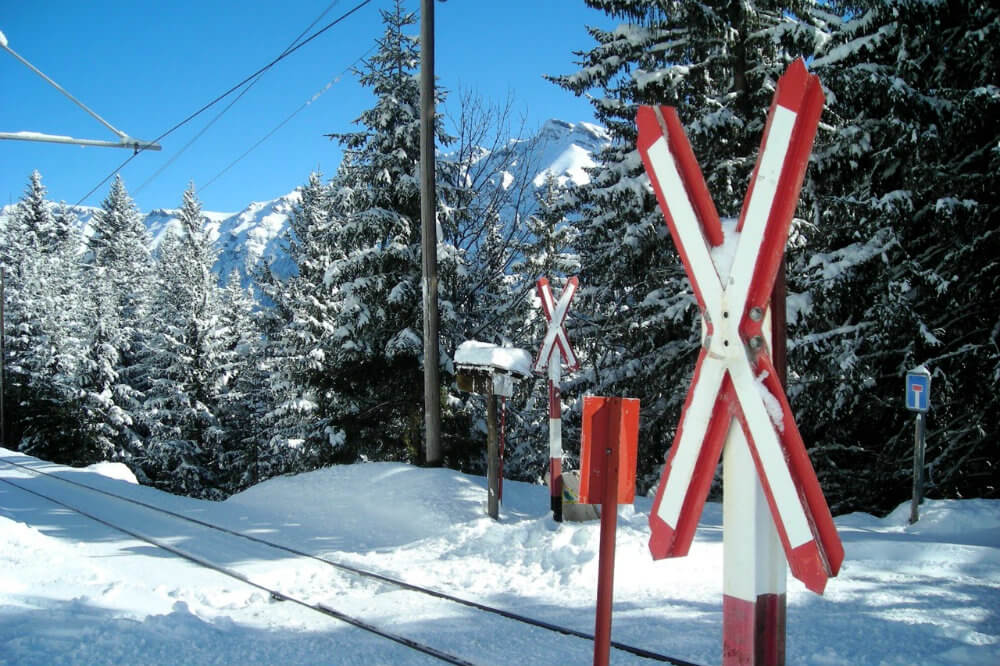
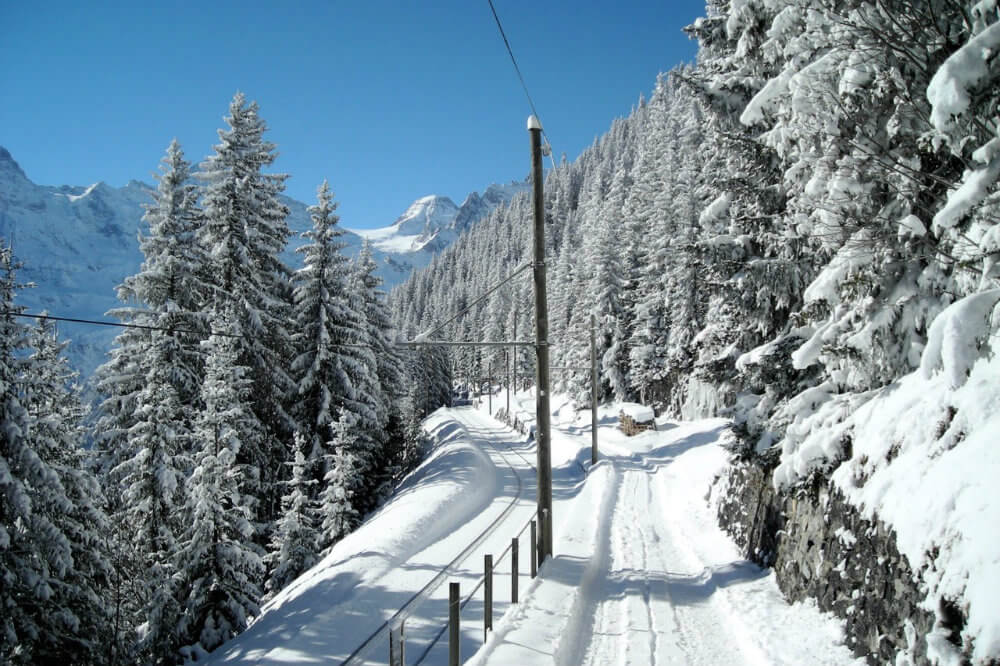
Winter Hiking Tips
Here is a summary of everything I learnt whilst Winter hiking in the Jungfrau region. Remember, I’m not an expert, therefore this post should be viewed as unqualified advice. Always seek the guidance of a professional if you’re unsure.
Winter Hiking Essentials
The following items are all absolutely essential for a safe and enjoyable Winter hike.
- Food. Think high protein, high fat/sugar items that will keep you sustained. I took chocolate bars and nuts.
- Water. Take a bottle of water with you. You’ll need it.
- Maps. Piste maps are normally free from your accommodation or from the tourist office and normally include hiking paths. Ask if you can’t find them.
- Pocket First Aid Kit. Light, pocketable and affordable first aid kits can be found in supermarkets and pharmacies.
- Mobile phone. Before heading out, make sure you have the phone number for your accommodation and the local SOS number saved in your phone.
- Mobile charger. Make sure you don’t run out of juice by taking a fully charged mobile charger.
- A comfortable waterproof bag. You’ll want a bag to hold everything in and you’ll certainly want that bag to be waterproof, well-fitted and comfortable.
Winter Hiking Costs
Equipment and essentials aside, costs for Winter hiking in the Jungfrau region are low. You just need to consider the cost of public transport to and from your chosen route. The Jungfrau – Top of Europe website has full details on transport and fares.
Follow the signs and markers
Probably the most important tip I can offer is that you follow the signs and markers. These can come in several forms:
- Permanent signposts are mostly yellow (sometimes purple) and normally states in hours and minutes how long it takes on average to reach the destination. You’ll normally see these at stations and intersections.
- Magenta signs are sometimes put up in snowy conditions and often just have ‘Wanderweg’ (‘hiking path’ in German) written on them.
- Path markers are simple plastic or wooden poles sticking out of the snow every 20-30 metres. The colour of the poles vary but they are more often than not purple with florescent stripes on them.
Other general tips
- If you’re serious about Winter hiking, you can buy specialist hiking equipment. You don’t really need to though. I coped just fine with hiking boots and insulated/waterproof snowboarding trousers.
- If you’re keen to hike but you don’t feel very confident about doing it alone, there are planned group hikes and snow-shoe hikes throughout the season that you can participate in. Check local information for details.
Warning: Winter hiking in the Jungfrau region can be dangerous! Always seek professional and local advice if you’re unsure. If something looks dangerous, it probably is, so trust your instincts.
Have I tempted you into trying Winter hiking in the Jungfrau region? Are you already an experienced Winter hiking pro? Share your stories & ask any questions you might have in the comments section below.
[htt-pinterest-img title=”A Non-Skier’s Guide to Winter Hiking in the Jungfrau Region” src=”https://heretotravel.com/wp-content/uploads/2018/11/winter-hiking-jungfrau-pinterest.jpg”]
Disclaimer: This post was not written by a Winter hiking expert. It was written by a reckless idiot who doesn’t know any better. This post should be viewed as a guide to the possibilities and pitfalls of Winter hiking and not as qualified advice.

